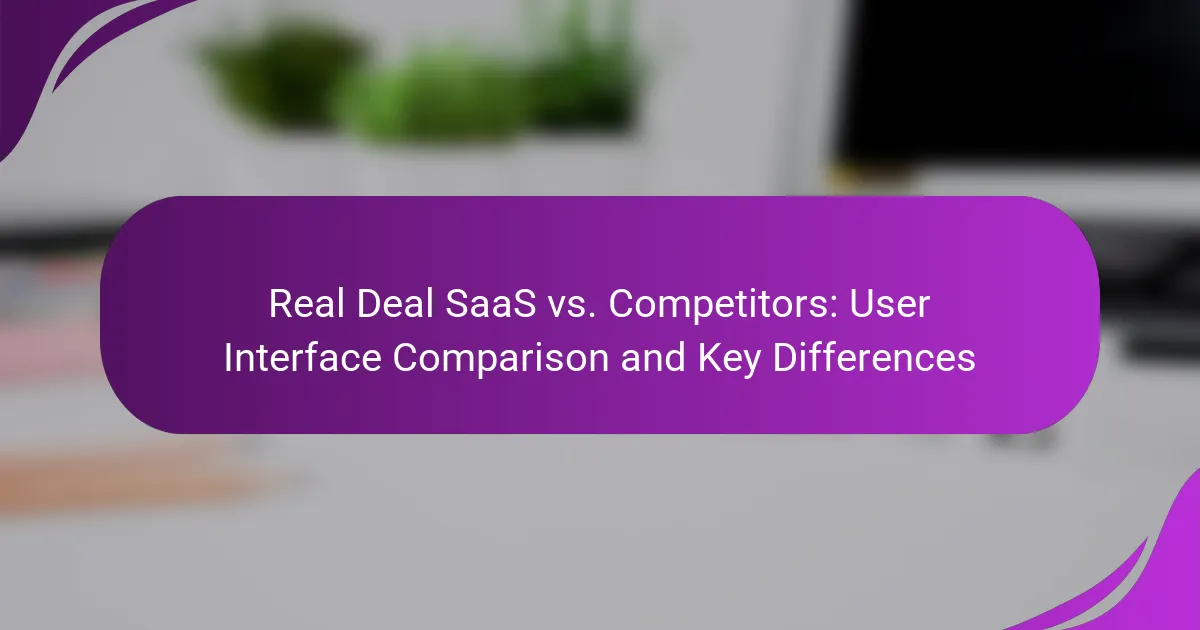Real Deal SaaS distinguishes itself with a user-friendly interface that emphasizes simplicity and an enhanced user experience. By focusing on intuitive design and responsive features, it effectively competes with other platforms, particularly in areas like onboarding, support, and user feedback mechanisms.

How does Real Deal SaaS compare to competitors in user interface design?
Real Deal SaaS stands out in user interface design by prioritizing simplicity and user experience. Its intuitive layout and responsive features make it a strong competitor against other platforms.
Intuitive navigation
Real Deal SaaS offers a streamlined navigation system that allows users to find essential features quickly. The main menu is organized logically, with clear labels that guide users through various functionalities without confusion.
In contrast, many competitors may have cluttered interfaces, making it harder for users to locate tools. A well-structured navigation system can significantly reduce the learning curve for new users.
Visual appeal
The visual design of Real Deal SaaS is modern and clean, utilizing a cohesive color palette and typography that enhances readability. This aesthetic not only attracts users but also contributes to an overall pleasant experience.
Competitors often vary in visual quality, with some using outdated designs that can detract from usability. A visually appealing interface can improve user satisfaction and engagement.
Customization options
Real Deal SaaS provides users with various customization options, allowing them to tailor the interface to their preferences. Users can adjust themes, layouts, and even dashboard widgets to create a personalized workspace.
While some competitors offer limited customization, Real Deal SaaS empowers users to optimize their experience, which can lead to increased productivity and satisfaction.
Mobile responsiveness
Real Deal SaaS is designed to be fully responsive, ensuring that users can access all features seamlessly on mobile devices. This adaptability is crucial as more users rely on smartphones and tablets for work.
Competitors may not prioritize mobile design, leading to a subpar experience on smaller screens. A responsive interface can significantly enhance usability and accessibility for on-the-go users.
Accessibility features
Real Deal SaaS incorporates several accessibility features to accommodate users with disabilities. This includes keyboard navigation, screen reader compatibility, and adjustable text sizes, ensuring that everyone can use the platform effectively.
Many competitors fall short in this area, lacking essential accessibility options. Prioritizing accessibility not only meets legal standards but also broadens the user base and enhances overall user experience.

What are the key differences in user experience?
The key differences in user experience between Real Deal SaaS and its competitors often lie in the onboarding process, support resources, and feedback mechanisms. These elements can significantly impact how effectively users can navigate the software and leverage its features.
Onboarding process
The onboarding process is crucial for user retention and satisfaction. Real Deal SaaS typically offers a streamlined onboarding experience, often featuring guided tutorials and interactive walkthroughs that help users get started quickly. In contrast, some competitors may have more complex setups that require additional time and effort to understand.
To enhance onboarding, consider utilizing tools that provide real-time assistance, such as chatbots or live support during the initial setup. This can reduce the learning curve and ensure users feel confident using the platform from day one.
Support resources
Support resources play a vital role in user experience, with Real Deal SaaS usually providing comprehensive documentation, video tutorials, and responsive customer service. This multi-faceted approach allows users to find solutions quickly, whether they prefer self-service options or direct assistance.
Competitors may vary in their support offerings, with some providing limited resources or slower response times. When evaluating options, check for availability of support channels like live chat, email, or phone support, as well as the hours of operation, which can impact user satisfaction.
Feedback mechanisms
Effective feedback mechanisms are essential for continuous improvement. Real Deal SaaS often incorporates user feedback through surveys, feature requests, and community forums, allowing users to voice their opinions and influence future updates. This engagement fosters a sense of community and ownership among users.
In contrast, some competitors may lack robust feedback channels, making it difficult for users to communicate their needs. When choosing a SaaS solution, prioritize platforms that actively solicit and act on user feedback to ensure the software evolves in line with user expectations.

What are the pricing models for Real Deal SaaS and its competitors?
Real Deal SaaS typically offers a subscription-based pricing model, similar to many of its competitors. Users can expect various tiers and options that cater to different needs, often including free trials and potential hidden fees that may affect overall costs.
Subscription tiers
Subscription tiers for Real Deal SaaS generally range from basic to premium levels, allowing users to select a plan that fits their requirements. Basic plans may start at around $10 to $30 per month, while premium tiers can exceed $100 monthly, depending on features and user limits.
Competitors often follow a similar structure, with some offering additional features like advanced analytics or priority support at higher tiers. It’s crucial to compare what each tier includes to ensure you get the best value for your investment.
Free trials
Real Deal SaaS usually provides a free trial period, allowing potential users to explore the platform without financial commitment. This trial often lasts between 14 to 30 days, giving users ample time to assess functionality and usability.
Many competitors also offer free trials, but the duration and features available during the trial can vary significantly. Always check the specifics to avoid surprises when transitioning to a paid plan.
Hidden fees
Hidden fees can be a concern with Real Deal SaaS and its competitors. Common additional costs may include charges for exceeding user limits, extra storage, or premium support services that are not included in the base subscription price.
To avoid unexpected expenses, carefully review the pricing details and terms of service before committing. It’s wise to ask customer support about any potential fees that may arise during usage to ensure complete transparency.

What integrations does Real Deal SaaS offer compared to others?
Real Deal SaaS provides a robust set of integrations that enhance its functionality compared to many competitors. Users can connect with a wide range of third-party applications, utilize API access for custom solutions, and easily manage data import and export processes.
Third-party app compatibility
Real Deal SaaS supports integration with numerous popular third-party applications, including CRM systems, accounting software, and marketing tools. This compatibility allows users to streamline workflows and enhance productivity by connecting their existing tools seamlessly.
Common integrations include platforms like Salesforce, QuickBooks, and Mailchimp. Users should evaluate their current software ecosystem to ensure that the integrations offered align with their operational needs.
API access
Real Deal SaaS offers comprehensive API access, enabling developers to create custom applications and automate workflows. This feature is particularly useful for businesses with unique requirements that standard integrations may not fully address.
API documentation is typically well-structured, allowing for easy implementation. Users should consider their technical capabilities and whether they have the resources to leverage API access effectively.
Data import/export options
Real Deal SaaS facilitates straightforward data import and export options, allowing users to migrate data from other systems or back up their information easily. Supported formats often include CSV and Excel, which are widely used for data management.
When planning data transfers, users should ensure that they follow best practices for data integrity and security. Regular backups and understanding the import/export limitations can help prevent data loss during transitions.

What are the performance metrics of Real Deal SaaS versus competitors?
The performance metrics of Real Deal SaaS generally indicate superior efficiency compared to its competitors, particularly in load times, uptime, and scalability. These factors are crucial for businesses relying on SaaS solutions to ensure optimal user experience and operational reliability.
Load times
Real Deal SaaS typically boasts load times in the low tens of milliseconds, which is competitive in the market. Fast load times enhance user satisfaction and retention, making it essential for SaaS providers to optimize their performance continuously.
In contrast, some competitors may experience load times that can reach several hundred milliseconds, potentially leading to user frustration. Businesses should prioritize solutions that consistently deliver quick access to their services.
Uptime statistics
Real Deal SaaS maintains an impressive uptime statistic, often exceeding 99.9%, which is a standard benchmark in the industry. This level of reliability ensures that users can access the service without significant interruptions.
Competitors may vary widely in their uptime performance, with some falling below 99%. Companies should carefully evaluate uptime guarantees when selecting a SaaS provider, as downtime can directly impact productivity and revenue.
Scalability
Real Deal SaaS is designed with scalability in mind, allowing businesses to easily adjust their usage based on demand. This flexibility is particularly beneficial for growing companies that may experience fluctuating workloads.
In comparison, some competitors may struggle with scalability, requiring significant reconfiguration or additional costs as user needs change. Organizations should assess how well a SaaS solution can scale to avoid future limitations and ensure seamless growth.
